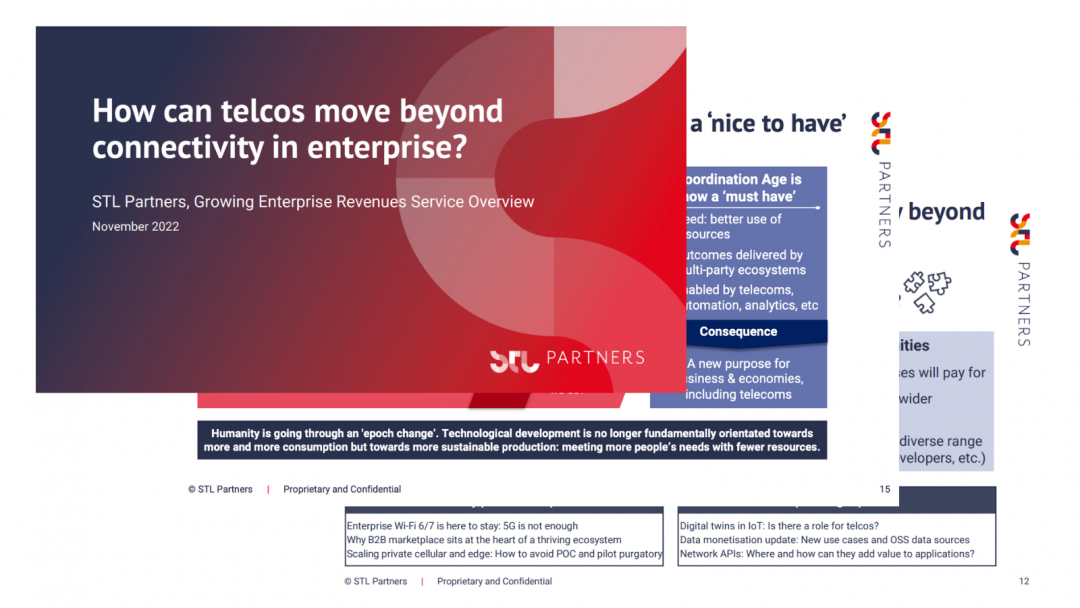
The Economy of Things: enabling the monetisation of IoT data
The Economy of Things (EoT) represents the natural transition of the Internet of Things (IoT). Whilst the IoT enables the generation of data from their devices and their sensors, the EoT can provide the means for the data to be transacted and monetised across a multi-participatory ecosystem. By 2030, at STL Partners we forecast that there will be 3.3 billion EoT enabled devices worldwide.
What is the Economy of Things?
We have seen an exponential increase in the number of IoT devices in the last decade. These devices generate exponential amounts of data that hold tremendous value and can be at the heart of many companies’ digital transformation journeys. However as of today the data generated is primarily unrealised and not yet business enabled.
The EoT transcends the IoT, enabling the monetisation of IoT data. Traditional IoT provides basic insights around a connected device and their behaviour specific to their application and environment. Transitioning to an EoT provides a means to provide more complex and meaningful insights around that data by making relevant data accessible in other systems and environments. The EoT offers the ability to anchor an identity to an IoT device in order to be able to transact on its own behalf, providing additional layers of transactional and behavioural data that haven’t really been there before.
Driving the transition from the IoT to the EoT relies on creating a platform that creates and encourages open participation and collaboration between a cross-industry ecosystem of partners. This helps bring the EoT into reality, creating a multi-participatory marketplace ecosystem and providing the fundamental brokerage of data products, services and IoT data across the platform.
Figure 1: Key characteristics of a successful EoT platform

Source: STL Partners
Vodafone are at the forefront of the EoT transition
Vodafone have paved the way in leading the transition to the EoT developing their Digital Asset Broker (DAB) platform which is underpinned by blockchain technology and was launched in 2022. The platform enables IoT devices to interact, transact and authenticate autonomously using a Vodafone enabled device. The unique capabilities of the DAB platform (Figure 2) also help establish an end-to-end trust model ensuring players across the EoT ecosystem rely on the data generated, sent and received from IoT devices.
Figure 2: Key characteristics of the Vodafone DAB platform

Source: STL Partners
Vodafone debut use case: EV charging
Vodafone’s debut use Electric Vehicle (EV) use case represents one of the leading industries capturing the EoT opportunity. This example allows an electric vehicle to autonomously transact with a charging point (Figure 3).
Figure 3: DAB platform enables autonomous payments over secure connection

Source: STL Partners
The use case provides several benefits across the EoT ecosystem. Motorists are notified of the real-time availability and status of nearby charging points eliminating ‘range anxiety’, the fear of running out of battery. The single application also eliminates the need for the multiple different apps that are currently required for different EV charging providers. The service is also particularly beneficial for fleet management companies as it provides a means to centralise and streamline their charging transactions across their company in a secure way.
Successful use cases are based around collective value
Whilst the possibilities of the EoT are endless, the real opportunities will come from where this is a focus on driving collective value across the ecosystem. All marketplace participants across the ecosystem, from the consumer to the enterprise must commercially benefit for the use case to be a success. (Figure 4).
Figure 4: Key players across the EoT ecosystem

What is the future of the EoT?
The growth of the EoT relies on building the ecosystem and promoting participation to facilitate true interoperability between different platforms, industries, and systems. Currently Vodafone has been the market leader for the transition to the EoT. As other operators transition from ‘telco to techco’, they could set up trusted marketplaces or license DAB technology to further propel the opportunity. Within the next five years, we predict that the EoT opportunity will really take-off fuelled by a continuing proliferation of IoT devices continuing to generate tremendous amounts of data, the value of which can be unlocked by the EoT (Figure 5). The timeline can only be further accelerated depending on how many ecosystem players can be onboarded.
Figure 5: STL Forecasts there will be over 3 billion EoT enabled devices by 2030

You can read about this in more depth in our full research report, “The Economy of Things: unlocking the true value of iot data“.
Download this article as a PDF
Read more about growing enterprise revenues
Growing Enterprise Revenues overview pack
Our overview pack explores how the telecoms industry can leverage new business models to meet enterprise customer needs
Telco APIs and Open Gateway: You can’t make an omelette without breaking some eggs
This article provides an assessment of where the market is to date post-MWC Barcelona, and what telcos can do to accelerate the opportunity.
Telco managed cybersecurity: incorporating cloud native application security
While the move to cloud native is a top priority for many enterprises, it introduces new security risks. There are individual solutions that minimise this risk, but a unified platform can offer a holistic approach. Telcos could strengthen their offerings by incorporating such platforms into their managed security services.
Network APIs: Unlocking new value in the telco cloud
Network APIs may offer an answer to the question of how to monetise recent and upcoming telco cloud deployments. Virtualised networks upgrade APIs and enhance the value they offer to developers and customers. To unlock their potential, telcos should focus on optimising their commercial models.





